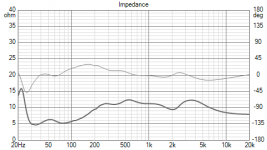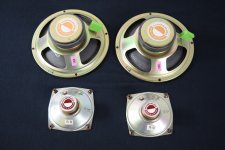Nominal impedance depends on the speakers components in the XO and the driver themselves.
It is far from being perfect, the impedance is a better definition (function of frequency) because it works together with the XO to create a good stable frequency response.
Impedance is especially relevant for tube amps to maximize the power output. For transistor amplifiers it is not relevant.
It is far from being perfect, the impedance is a better definition (function of frequency) because it works together with the XO to create a good stable frequency response.
Impedance is especially relevant for tube amps to maximize the power output. For transistor amplifiers it is not relevant.
...
Not surprisingly, some "exotics" claim 4 ohm but drop to scary 2 ohm at some frequencies. Oh well.
I say thay 2 ohms aren't scary, it's just that most amplifiers are pussies
An 8 ohm rated speaker will have a measured impedance of 8 ohm at a frequency of 400Hz.
i.e. 400Hz is the reference frequency at which speaker impedances are measured.
Really? Why not 1kHz or at Fs
I always understood that the speaker was rated at any "Nominal" cross over frequency, hence the BBC monitors at 15 and 16Ohm rating.
Not that I actually know anything of course. At least we can be reasonably precise about DCR
It happened that the first compression driver designed by Western Electric for movie theater was 4 ohms all by hazard. Bigger theaters used two or even four horns in series , for which the WE amplifiers had their output transformers adjustable . Third party suppliers had to propose the same impedance replacement equipment, after which 4/8/16 became standards in US . The British used as usual different values .At lunch yesterday a friend asked a simple question I could not answer: Why are speakers usually designed and specified at some common impedance such as 2. 4, 8, or 16 ohms, and where did the standard come from?
Embarrassed, I searched for this without success. Explanations of speaker impedance quickly devolved into water pipe analogies and "What is an ohm?"
I understand impedance and I know that speaker impedance is not constant with frequency and that the nominal value is just an approximation. What I
can't seem to find is where the common nominal values (standards?) come
from. Some committee? Commercial practicality? Implied from required
speaker dynamics?
Any light you can shed would be appreciated.
Last edited:
It could equally well be 1 kHz, as I remember it being quoted back in my early days!Really? Why not 1kHz or at Fs
What I really meant to say was that a measurement of the impedance at 400Hz gives a good indication of the nominal impedance of an unmarked driver (tweeter excepted).
Read JM Fahey's earlier post in which my statement is backed up.
"The above definition "nominal impedance 20% above minimum" happens around 400Hz in many speakers, so it´s not a bad generic answer."
My old Infinity RS 4500 speakers were labelled 6Ω as there was a 4 Ω woofer and the mid & tweeter were both 8Ω. Algebra.
Your speaker’s crossover may very well have had a woofer inductor with an ohm or two DCR.
Then there's this document:
https://www.isce.org.uk/wp-content/uploads/EngineeringNote-11.3-loudspeakers-impedance-and-power.pdf
Which states:
"The (IEC) standard goes on to say that the minimum impedance within the rated frequency range shall not be less than 0.8 of the rated impedance,...
Well, at least that's a clear cut definition from a reputable source (the IEC). But it also means that one tweak the impedance rating by declaring a suitable "rated frequency range".
Take a look at the attached loudspeaker impedance curve, which might have a "rated frequency range" of 40 Hz to 20 kHz or so (I know because I designed and built that speaker). The impedance drops to just below 5 Ohm at 35 Hz, so this would go as a 4 Ohm speaker. If the "rated frequency range" would be specified as 150 Hz to 20 kHz instead, this would change to an 8 Ohm speaker (without changing the speaker in any way, really). Using the "400 Hz" rule, one might even claim this to be a 16 Ohm speaker.
I guess the lesson here is that one should stop caring about the "nominal impedance" rating and always look at the entire impedance curve!
Attachments
I wonder what the story behind these 33R drivers is?I guess that explains why 16R is usually the highest impedance you find and getting 24R is difficult/expensive.
Attachments
- Status
- This old topic is closed. If you want to reopen this topic, contact a moderator using the "Report Post" button.
- Home
- Loudspeakers
- Multi-Way
- Why 2/4/8/16 ohms?



